Overhead Cranes & Gantry Cranes for Rapid Prototyping & Manufacturing
Rapid prototyping and manufacturing have revolutionized various industries, including product design, aerospace, automotive, healthcare, and more. These technologies allow for faster and more cost-effective development cycles, enabling companies to iterate and test designs more efficiently before proceeding with full-scale production. Additionally, rapid manufacturing has opened up possibilities for creating complex geometries that would be difficult or impossible to achieve using traditional manufacturing methods.
Guide to Types of Cranes Used in Prototyping and Manufacturing Industries
In the world of prototyping and manufacturing, cranes play a crucial role in material handling, assembly, and transportation of heavy components and equipment. Different types of cranes are used based on the specific needs of each industry, the size and weight of materials being handled, and the layout of the workspace. In this guide, we will explore various types of cranes commonly used in prototyping and manufacturing industries, along with their applications, benefits, and considerations for safe and efficient operation.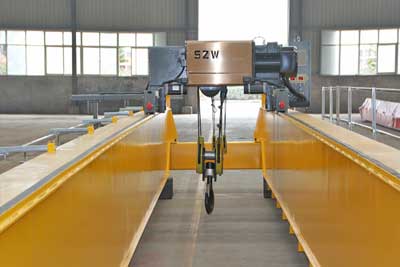
Bridge Cranes (EOT Cranes - Electric Overhead Traveling Cranes):
- Description: Bridge cranes, also known as Electric Overhead Traveling (EOT) cranes, are among the most widely used types of cranes in manufacturing industries. They consist of a horizontal beam (bridge) that travels along rails mounted on elevated runways. The bridge is equipped with a hoist and trolley system that allows vertical lifting and lateral movement of heavy loads.
- Applications: Aerospace: Bridge cranes are used to move large aircraft components within assembly areas or hangars. Automotive: In automotive manufacturing plants, bridge cranes lift and move heavy car parts during assembly. Industrial Equipment: Bridge cranes facilitate the handling of heavy machinery and equipment during manufacturing and assembly processes.
- Benefits: High lifting capacity. Precise control for accurate positioning. Ability to cover a large working area. Suitable for heavy-duty applications.
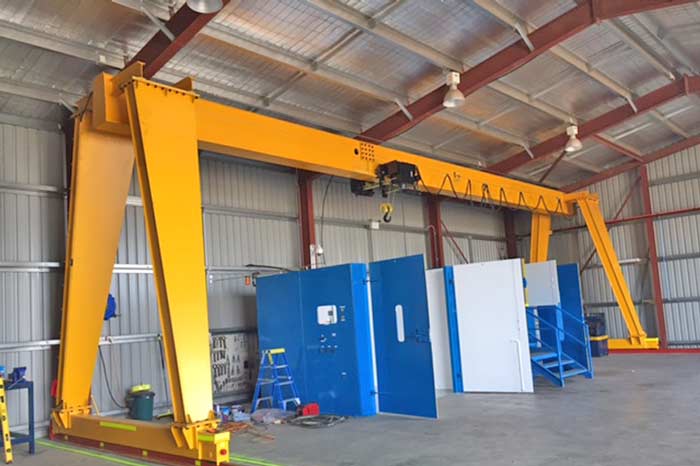
Gantry Cranes:
- Description: Gantry cranes are similar to bridge cranes, but they are supported by legs on the ground, rather than elevated runways. They are versatile cranes used both indoors and outdoors and can be mobile or fixed in place.
- Applications: - Construction: Gantry cranes are used on construction sites to lift and move heavy construction materials like steel beams and concrete panels.
- Architecture: Gantry cranes are used in architectural model-making workshops to handle large-scale models and materials.
- Benefits: - Easy to install and move.Suitable for outdoor applications.Excellent for handling bulky and heavy materials.
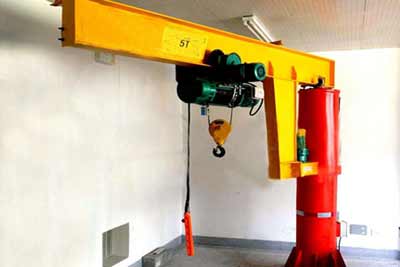
Jib Cranes:
- Description: Jib cranes consist of a horizontal arm (jib) that is mounted on a vertical pillar or wall. They are typically used in areas where a full overhead crane system is not feasible or necessary.
- Applications: - Aerospace: Jib cranes can be useful for precise lifting and positioning of aircraft components in smaller assembly areas.
- Healthcare and Medical Devices: Jib cranes may be utilized in medical device manufacturing for handling delicate and precise equipment.
- Benefits: - Space-saving design.Precise and localized lifting.Cost-effective solution for specific tasks.
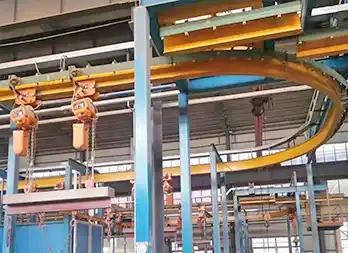
Monorail Cranes:
- Description: Monorail cranes consist of a single rail or track on which a trolley moves, allowing lateral movement along the track. They are ideal for applications that require moving loads along a linear path.
- Applications: - Consumer Electronics: Monorail cranes are used in electronics manufacturing for moving products along the production line. Entertainment and Gaming: Monorail cranes aid in the handling of large props and sets in the entertainment industry.
- Benefits: - Efficient for linear material handling. Space-saving design. Suitable for repetitive tasks.
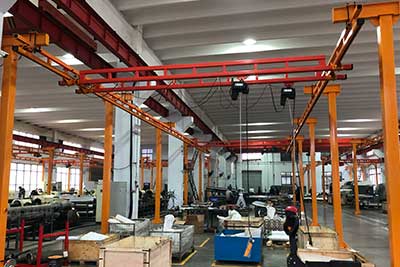
Workstation Bridge Cranes: Description:
- Workstation bridge cranes are smaller, lighter versions of bridge cranes designed for individual workstations or specific work areas.
- Applications: Consumer Goods: Workstation bridge cranes are suitable for lifting and moving heavy materials during consumer goods manufacturing.
- Benefits: Easy to install and relocate. Ideal for focused material handling at specific workstations.
Considerations for Safe Operation:
- 1. Training: Operators should receive proper training and certification to operate cranes safely and efficiently.
- 2. Maintenance: Regular maintenance and inspection are essential to ensure the cranes are in good working condition.
- 3. Load Capacity: Always adhere to the crane's load capacity, and avoid overloading it.
- 4. Safety Features: Cranes should be equipped with safety features like limit switches and emergency stop buttons.
- 5. Workspace Layout: Consider the layout of the workspace when choosing the type of crane to ensure it fits the available space.
Cranes are indispensable tools in the prototyping and manufacturing industries, enabling efficient material handling and assembly processes. The choice of crane type depends on the specific needs of each industry and the tasks to be performed. By selecting the appropriate crane and adhering to safety guidelines, businesses can enhance productivity, optimize workflows, and ensure a safe working environment.
Overhead Crane used for various Rapid prototyping and manufacturing industries
Rapid prototyping and manufacturing technologies have found applications across various industries due to their versatility and efficiency. Some of the typical industries that extensively use rapid prototyping and manufacturing include:Aerospace, Automotive, Healthcare and Medical Devices, Consumer Electronics, Industrial Equipment, Architecture and Construction, Jewelry and Fashion, Education and Research, Entertainment and Gaming, Consumer Goods, etc.
The range of applications for rapid prototyping and manufacturing continues to expand as the technology advances and becomes more accessible to different industries. Its ability to reduce development times, increase design flexibility, and enable cost-effective small-batch production has made it an invaluable tool across various sectors.
Overhead cranes are used to lift, move, and position heavy loads, making them essential in industries that deal with large and bulky materials or components. Here are some specific applications of overhead cranes in the mentioned industries:
1. Aerospace:
- Types of Cranes: Bridge Cranes (EOT Cranes): Electric Overhead Traveling (EOT) cranes with a bridge that travels along elevated runways. Jib Cranes: Cranes with a horizontal arm (jib) mounted on a vertical pillar or wall.
- Applications: Bridge Cranes: Used to move large aircraft components within assembly areas or hangars. Jib Cranes: Useful for precise lifting and positioning of aircraft components in smaller assembly areas.
- Features and Benefits: Bridge Cranes: High lifting capacity, precise control for accurate positioning, and ability to cover a large working area. Jib Cranes: Space-saving design, localized lifting, and cost-effective solution for specific tasks in limited spaces.
2. Automotive:
- Types of Cranes: Bridge Cranes (EOT Cranes): Electric Overhead Traveling (EOT) cranes with a bridge that travels along elevated runways.
- Applications: Bridge Cranes: Used in automotive manufacturing plants to lift and move heavy car parts during assembly.
- Features and Benefits: Bridge Cranes: High lifting capacity, precise control, and ability to cover a large working area, facilitating efficient assembly line processes.
3. Industrial Equipment:
- Types of Cranes: Bridge Cranes (EOT Cranes): Electric Overhead Traveling (EOT) cranes with a bridge that travels along elevated runways.
- Applications: Bridge Cranes: Facilitate the handling of heavy machinery and equipment during manufacturing and assembly processes.
- Features and Benefits: Bridge Cranes: High lifting capacity and precise control, making them suitable for heavy-duty applications in industrial settings.
4. Construction:
- Types of Cranes: Gantry Cranes: Supported by legs on the ground, versatile cranes used both indoors and outdoors, can be mobile or fixed in place.
- Applications: Gantry Cranes: Used on construction sites to lift and move heavy construction materials like steel beams and concrete panels.
- Features and Benefits: Gantry Cranes: Easy to install and move, suitable for outdoor applications, and excellent for handling bulky and heavy materials.
5. Architecture:
- Types of Cranes: Gantry Cranes: Supported by legs on the ground, versatile cranes used both indoors and outdoors, can be mobile or fixed in place.
- Applications: Gantry Cranes: Used in architectural model-making workshops to handle large-scale models and materials.
- Features and Benefits: Gantry Cranes: Easy to install and move, suitable for indoor model-making, and excellent for handling large and bulky materials.
6. Entertainment and Gaming:
- Types of Cranes: Monorail Cranes: Consist of a single rail or track on which a trolley moves, allowing lateral movement along the track.
- Applications: Monorail Cranes: Aid in the handling of large props and sets in the entertainment industry.
- Features and Benefits: Monorail Cranes: Efficient for linear material handling, space-saving design, and suitable for repetitive tasks in the entertainment industry.
7. Consumer Goods:
- Types of Cranes: Workstation Bridge Cranes: Smaller, lighter versions of bridge cranes designed for individual workstations or specific work areas.
- Applications: Workstation Bridge Cranes: Suitable for lifting and moving heavy materials during consumer goods manufacturing.
- Features and Benefits: Workstation Bridge Cranes: Easy to install and relocate, ideal for focused material handling at specific workstations in consumer goods manufacturing.
While overhead cranes are essential in these industries for specific tasks, it's important to note that not all businesses within these industries may require their installation. The use of overhead cranes depends on the scale of production, the weight and size of the materials or products being handled, and the specific needs of each manufacturing or production facility. Additionally, workplace safety regulations and considerations play a crucial role in determining the necessity and proper use of overhead cranes in any industry.




